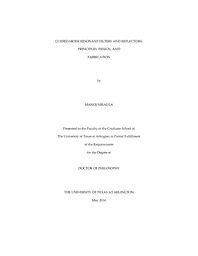| dc.description.abstract | Thin-film structures incorporating wavelength-scale gratings provide functionalities for applications in various optical systems. Previously, spectral filters, wideband reflectors, and polarizers have been identified as potential application areas. In this dissertation, we overview the operational principles of these resonant periodic structures, discuss the methods of their design and fabrication, and propose and demonstrate novel functionalities for spatial and spectral filtering, and unpolarized wideband reflection. Fashioned with materially sparse gratings, these optical devices are easy to fabricate and integration friendly compared to their traditional multi-layer counterparts making their research and development critical for practical applications.
We study, theoretically, modal properties and parametric dependence of resonant periodic bandpass filters operating in the mid- and near-infrared spectral domains. We investigate three different device architectures consisting of single, double, and triple layers based on all-transparent dielectric and semiconductor thin films. The three device classes show high-performance bandpass filter profiles with broad, flat low-transmission sidebands accommodating sharp transmission peaks with their efficiencies approaching 100% with appropriate blending of multiple guided modes. We present three modal coupling configurations forming complex mixtures of two or three distinct leaky modes coupling at different evanescent diffraction orders. These modal compositions produce various widths of sidebands ranging from ~30 nm to ~2100 nm and transmission peak-linewidths ranging from ~1 pm to ~10 nm. Our modal analysis demonstrates key attributes of subwavelength periodic thin-film structures in multiple-modal blending to achieve desired transmission spectra.
We provide the first experimental demonstration of high-efficiency and narrow-linewidth resonant bandpass filter applying a single patterned silicon layer on a quartz substrate. Its performance corresponds to bandpass filters requiring 15 traditional Si/SiO2 thin-film layers. The feasibility of sparse narrowband, high-efficiency bandpass filters with extremely wide, flat, and low sidebands is thereby demonstrated. This class of devices is designed with rigorous solutions of Maxwell’s equations while engaging the physical principles of resonant waveguide gratings. An experimental filter presented exhibits a transmittance of ~72%, bandwidth of ~0.5 nm, and low sidebands spanning ~100 nm. The proposed technology is integration-friendly and opens doors for further development in various disciplines and spectral regions where thin-film solutions are traditionally applied.
We demonstrate concurrent spatial and spectral filtering as a new outstanding attribute of resonant periodic devices. This functionality is enabled by a unique, near-complete, reflection state that is discrete in both angular and spectral domains and realized with carefully crafted nanogratings operating in the non-subwavelength regime. We study the pathway and inter-modal interference effects inducing this intriguing reflection state. In a proof-of-concept experiment, we obtain angular and spectral bandwidths of ~4 mrad and ~1 nm, respectively. This filter concept can be used for focus-free spectral and spatial filtering in compact holographic and interferometric optical instruments.
We report unpolarized broadband reflectors enabled by a serial arrangement of a pair of polarized subwavelength gratings. Optimized with inverse numerical methods, our elemental gratings consist of a partially etched crystalline-silicon film on a quartz substrate. The resulting reflectors exhibit extremely wide spectral reflection bands in one polarization. By arranging two such reflectors sequentially with orthogonal periodicities, there results an unpolarized spectral band possessing bandwidth exceeding those of the individual polarized bands. In the experiments reported herein, we achieve zero-order reflectance exceeding 97% under unpolarized light incidence over a 500-nm-wide wavelength band in the near-infrared domain. Moreover, the resonant unpolarized broadband accommodates an ultra-high-reflection band spanning ~85 nm and exceeding 99.9% in efficiency. The elemental polarization-sensitive reflectors based on one-dimensional resonant gratings have simple design, robust performance, and are straightforward to fabricate. Hence, this technology is a promising alternative to traditional multilayer thin-film reflectors especially at longer wavelengths of light where multilayer deposition may be infeasible or impractical.
We demonstrate an interesting attribute of resonant bandpass filters which is high angular stability for fully conical light incidence. Fashioning an experimental bandpass filter with a subwavelength silicon grating on a quartz substrate, we show that fully conical incidence provides an angular full-width at half-maximum linewidth of ~9.5° compared to a linewidth of ~0.1° for classical incidence. Slow angular variation of the central wavelength with full conical incidence arises via a corresponding slow angular variation of the resonant second diffraction orders driving the pertinent leaky modes. Moreover, full conical incidence maintains a profile with a single passband as opposed to the formation of two passbands characteristic of resonant subwavelength gratings under classical incidence. Our experimental results demonstrate excellent stability in angle, spectral profile, linewidth, and efficiency.
Finally, we propose a novel method of design and fabrication of photonic lattices that incorporates the best of both worlds: a polarized resonant grating can be designed and converted to its unpolarized lattice equivalent using the same design parameters to obtain a similar performance. We show this in context of a single-layer polarized bandpass filter operating at 1550 nm with ~100% transmission efficiency. An unpolarized square-hole lattice with identical parameters operates as a bandpass filter at ~1560 nm with ~70% transmission efficiency. Moreover, conventional laser interference lithography technique for mask patterning is limited to circular-hole photoresist lattice. We propose a method to lay down a metal hard-mask by lifting-off patterned photoresist in two steps for a square-hole lattice. Our comprehensive study provides new principles for easy design and fabrication of square-hole photonic lattices for unpolarized guided-mode resonance applications. | |


